Cozy & Creamy Winter Roasted Vegetable Risotto: Your Ultimate Comfort Food Recipe
As the days grow shorter and the air turns crisp, there’s nothing quite like a warm, comforting meal to bring a sense of hygge to your home. Our Winter Roasted Vegetable Risotto is designed to do just that – it’s a dish bursting with deep, savory flavors, perfectly suited for cozying up. Imagine tender, earthy roasted root vegetables folded into a luxurious, creamy Arborio rice base, creating a truly unforgettable culinary experience. This isn’t just a meal; it’s an invitation to slow down and savor the season.
Whether you’re planning a hearty family dinner, perhaps serving it alongside a perfectly seared steak or a golden roasted chicken, or simply yearning for a romantic date night in with a robust bottle of red wine, this easy-to-master risotto is an absolute must-have for your winter repertoire. It elegantly serves four, making it ideal for intimate gatherings or enjoying delicious leftovers. Prepare to fall in love with its rich textures and heartwarming taste.
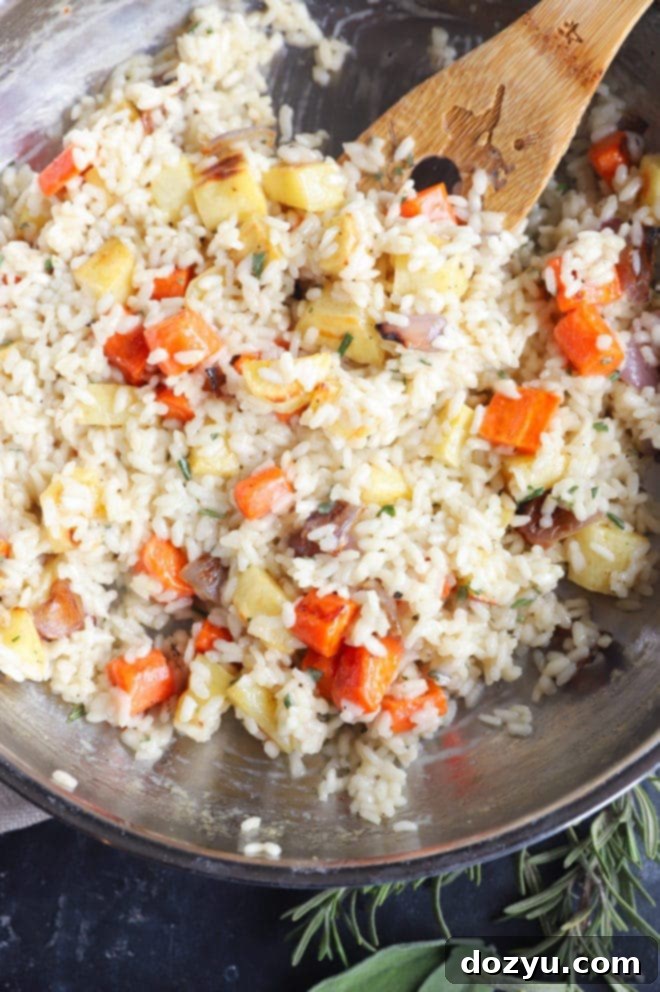
The Joy of Homemade Risotto: A Culinary Slow Down
For many, risotto feels like a dish reserved for fancy restaurants – a true luxury. However, I’m here to tell you that recreating this indulgent experience right in your own kitchen is not only entirely achievable but also surprisingly simple. It’s truly one of my favorite dishes to prepare, precisely because it encourages a mindful approach to cooking.
This recipe isn’t about rushing. It’s about embracing the slow, enjoyable rhythm of culinary creation. Picture yourself standing by the stove, a soothing glass of wine or your preferred beverage in hand, gently stirring the Arborio rice as it gradually transforms into a creamy, bubbling masterpiece. I often use this time to catch up on my favorite podcasts or put on a beloved show on the iPad. It’s a precious moment for me to unwind, especially in the delightful whirlwind of raising a toddler – a cherished pause in an otherwise busy day.
With every perfect spoonful of this creamy roasted vegetable risotto, you’ll discover a symphony of flavors and textures: the earthy sweetness of perfectly roasted vegetables mingling with the rich, velvety grains of rice. There’s no need to save this incredible recipe for a special occasion; its comforting embrace and delightful taste make it a perfect candidate to become a cherished seasonal favorite in your home.
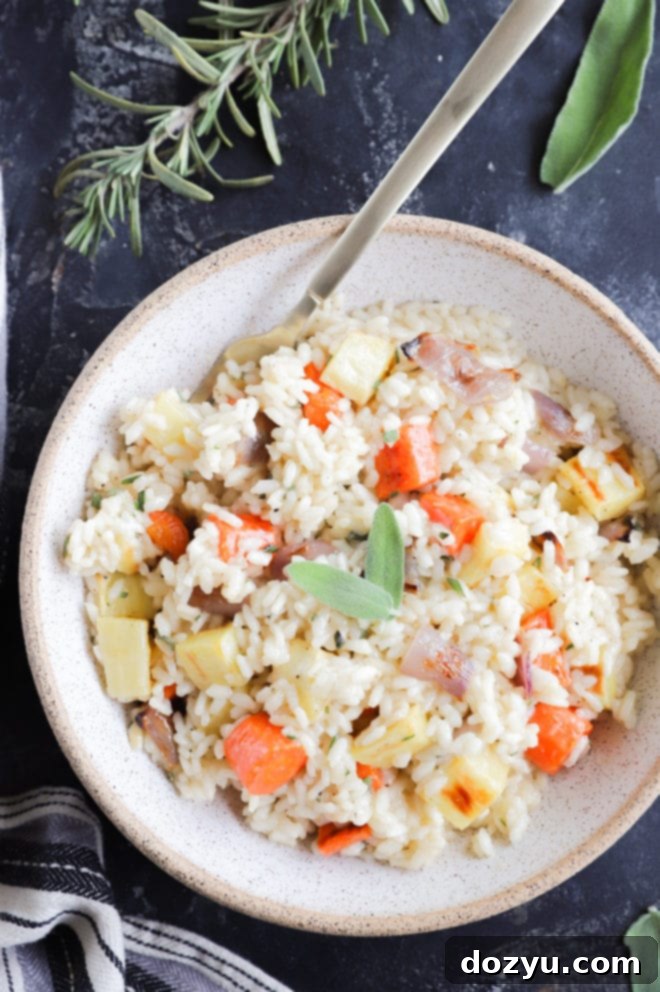
Table of Contents
Toggle
Key Ingredients for Our Hearty Risotto
Every exceptional dish starts with high-quality ingredients. For this Winter Roasted Vegetable Risotto, we focus on a selection of root vegetables and pantry staples that come together to create a deeply satisfying and flavorful experience. Here’s a closer look at the stars of our recipe:
-
Parsnip: Often overlooked, the parsnip is a delightful cousin to the carrot that truly shines when roasted. Its natural sugars caramelize, developing a slightly sweet, nutty flavor with lovely earthy undertones that perfectly complement the creamy risotto. Don’t skip this unique root vegetable – it’s a winter essential!
-
Carrot: The humble carrot is a versatile powerhouse, and its flavor intensifies beautifully with roasting. It adds a vibrant color and a familiar sweetness, providing a grounding flavor to the dish. For a slight variation, you could also substitute carrots with cubes of hearty butternut squash, which offers a similar sweetness and texture profile when roasted.
-
Red Onion: Roasting red onion mellows its pungent bite, transforming it into a wonderfully sweet and slightly smoky addition that harmonizes perfectly with the other roasted vegetables. If red onion isn’t available, a white onion would be the next best choice for its mildness, followed by yellow onion, both providing a good base flavor.
-
Chicken or Vegetable Stock: This is the backbone of your risotto’s flavor and texture. Using a good quality chicken or vegetable stock adds incredible depth and richness, far surpassing what plain water could offer. The savory notes from the stock infuse into every grain of rice, creating a more complex and satisfying dish. Ensure it’s warmed before adding!
-
Garlic: The aromatic foundation of many great dishes, garlic brings a pungent warmth and depth. While mincing fresh garlic is always an option for the most robust flavor, I often opt for pre-minced garlic in a jar for convenience – it saves time and keeps your hands free from the lingering scent of garlic!
-
Arborio Rice: This is arguably the most crucial ingredient for authentic risotto. Arborio rice is a short-grain variety known for its high starch content, which is essential for achieving that characteristic creamy texture without adding actual cream. When cooked slowly and with consistent stirring, it releases its starches, creating a velvety sauce. While technically you could use long-grain rice, it requires a different liquid ratio and won’t yield the same luxurious creaminess that Arborio rice provides.
-
Dry White Wine: A cup of dry white wine, such as Chardonnay, adds a bright acidity and complex layer of flavor that beautifully balances the richness of the risotto. It’s added early in the cooking process to deglaze the pan and its alcohol cooks off, leaving behind a subtle, sophisticated taste.
-
Fresh Herbs (Sage & Rosemary): The aromatic duo of fresh sage and rosemary introduces delightful herbaceous notes that truly evoke the essence of winter. These fragrant herbs elevate the overall flavor profile, adding a layer of sophisticated warmth and freshness. Feel free to experiment with other fresh herbs like thyme or even a touch of basil for a different twist.
-
Parmesan Cheese & Butter: These are indispensable for the final creamy, rich finish. Grated Parmesan cheese adds a salty, umami depth and contributes to the velvety texture, while a knob of unsalted butter stirred in at the end provides an incomparable silken texture and glossy sheen. They are non-negotiable for true risotto perfection and contribute significantly to its luxurious mouthfeel.
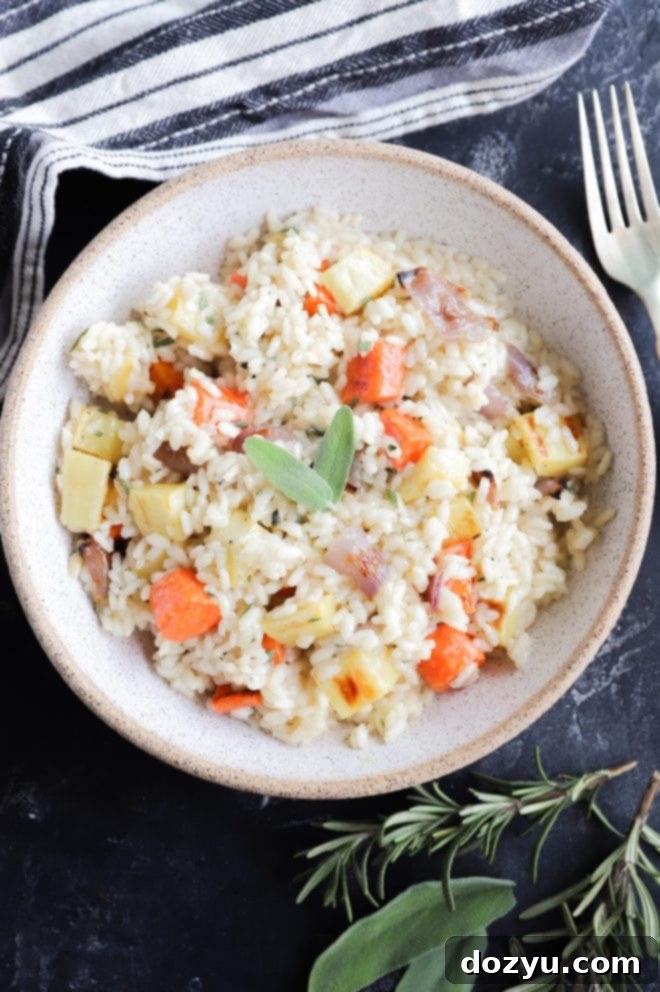
Essential Equipment for Your Risotto Journey
Having the right tools can make all the difference in your cooking experience. For this delightful winter risotto, a few key pieces of equipment will ensure smooth sailing from prep to plating, making the process enjoyable and efficient:
-
Cutting Board and Chef’s Knife: These foundational kitchen tools are essential for safely and efficiently prepping all your beautiful vegetables. A sharp chef’s knife makes light work of chopping and dicing, ensuring your ingredients are ready for roasting.
-
High-Sided Skillet (or Risotto Pot): A good quality, large skillet with tall sides is ideal for risotto. It provides ample surface area for the rice to cook evenly and enough depth to contain the liquid as you stir, preventing splatters. The high sides also help retain heat, which is important for the gradual cooking process. My favorite risotto skillet is perfectly sized for this recipe, and even allows for easy doubling if you’re feeding a larger crowd.
-
Sturdy Wooden Spoon: You’ll be doing a fair amount of stirring, so a comfortable and sturdy wooden spoon is a must. It’s gentle on your non-stick cookware and perfect for scraping the bottom of the pan to prevent sticking and ensure even cooking and starch release.
-
Small Saucepan: For warming your stock. Keeping the stock warm is a critical step in risotto making, as adding cold liquid can shock the rice and interrupt the cooking process, affecting the final texture of your creamy risotto.
-
Baking Sheet with Parchment Paper/Silicone Mat: Essential for roasting your vegetables evenly and preventing them from sticking, ensuring a quick and easy cleanup.
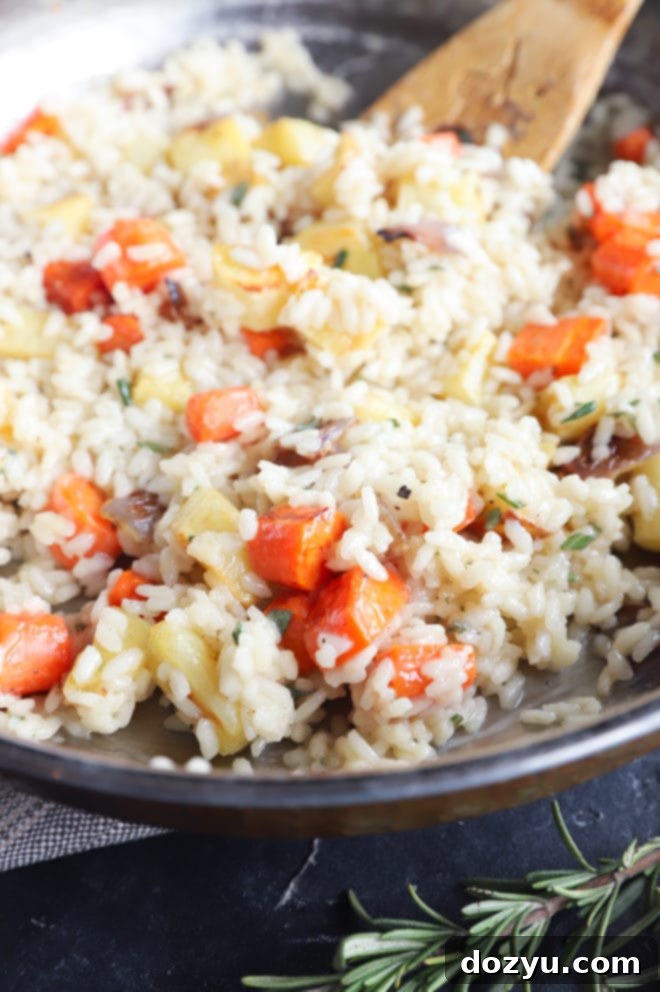
Crafting Your Winter Roasted Vegetable Risotto: A Step-by-Step Guide
Making a truly exceptional risotto at home involves a few key steps that are not overly complicated but require attention and a little patience. Follow this detailed guide to create a delicious and satisfying winter comfort meal with perfectly cooked Arborio rice and tender, flavorful roasted vegetables:
Step 1: Roast Vegetables for Enhanced Flavor
Begin by preheating your oven to a robust 400˚F (200˚C). Prepare a baking sheet by lining it with parchment paper or a silicone mat – this ensures easy cleanup and prevents sticking. In a large mixing bowl, combine the uniformly chopped parsnip, carrots, and red onion. Drizzle them with 2 teaspoons of olive oil, then season generously with a good pinch of salt and freshly ground black pepper. Toss everything together until the vegetables are lightly coated. Spread the seasoned vegetables in a single layer on the prepared baking sheet, ensuring they have enough space to roast without steaming. Roast for approximately 15 to 20 minutes, or until they are beautifully tender and slightly caramelized at the edges. This roasting process deepens their natural sweetness and intensifies their earthy flavors, which is crucial for the risotto’s overall taste. Once roasted, carefully remove them from the oven and set them aside to cool slightly while you prepare the risotto base.
Step 2: Prepare Stock & Toast Rice
Before diving into the rice, ensure your stock is ready. Pour your chicken or vegetable stock into a small saucepan and gently heat it over medium heat until it’s warmed through but not boiling. It’s vital to keep it covered and on low heat throughout the entire risotto cooking process – adding warm stock prevents shocking the rice, which can disrupt its cooking and affect the final creamy texture. In a large, high-sided skillet, heat 1 tablespoon of olive oil over medium heat. Add the minced garlic and cook for about 30 seconds to 1 minute, stirring constantly, until it’s fragrant and just lightly browned. Be careful not to burn it! Stir in the Arborio rice and toast it for about 2 minutes, stirring occasionally. You’ll notice the edges of the rice grains becoming translucent and taking on a lightly golden hue. This toasting step (called tostatura) helps the rice maintain its structure and prevents it from becoming mushy, while also developing a nutty flavor.
Step 3: The Classic Risotto Stir: Cook & Stir
Pour in the dry white wine (a Chardonnay works beautifully for its crisp notes). Allow it to simmer and reduce, stirring gently, until almost all the liquid has evaporated. The wine adds a wonderful layer of acidity and complexity, and its alcohol cooks off at this stage. Now, begin the gradual addition of your warm stock: add approximately 1 cup of the warmed stock to the rice mixture, stirring frequently. Continue to stir gently as the rice absorbs the liquid. This consistent stirring is paramount to releasing the starches from the Arborio rice grains, which is what ultimately creates that signature velvety, creamy texture. Once the stock has been almost completely absorbed (you should see the bottom of the pan when you drag your spoon across it), repeat this process, adding another 1 cup of stock at a time and stirring until each addition is absorbed. Continue until the rice is cooked through to an al dente consistency – meaning it’s tender but still retains a slight, pleasant bite in the center. Remember, you might not need to use all the stock; taste test the rice between each addition to check for doneness. Typically, this patient cooking phase takes about 25 to 35 minutes in total.
Step 4: Finishing Touches for Creaminess & Flavor
Once the rice has reached its perfect al dente stage, remove the skillet from the heat. This is where the magic happens for ultimate creaminess! Stir in the grated Parmesan cheese and the unsalted butter until both are completely melted and fully incorporated. This final stir, known as mantecatura, creates a wonderfully creamy, glossy, and luxurious texture. Next, gently fold in the freshly chopped herbs – the aromatic sage and rosemary – which will awaken your senses with their delightful fragrance. Finally, add your beautifully roasted vegetables and carefully stir them into the risotto to combine evenly. Taste the finished risotto and season with additional salt and freshly ground black pepper as needed to enhance all the flavors. Serve immediately in warm bowls and savor every comforting bite!
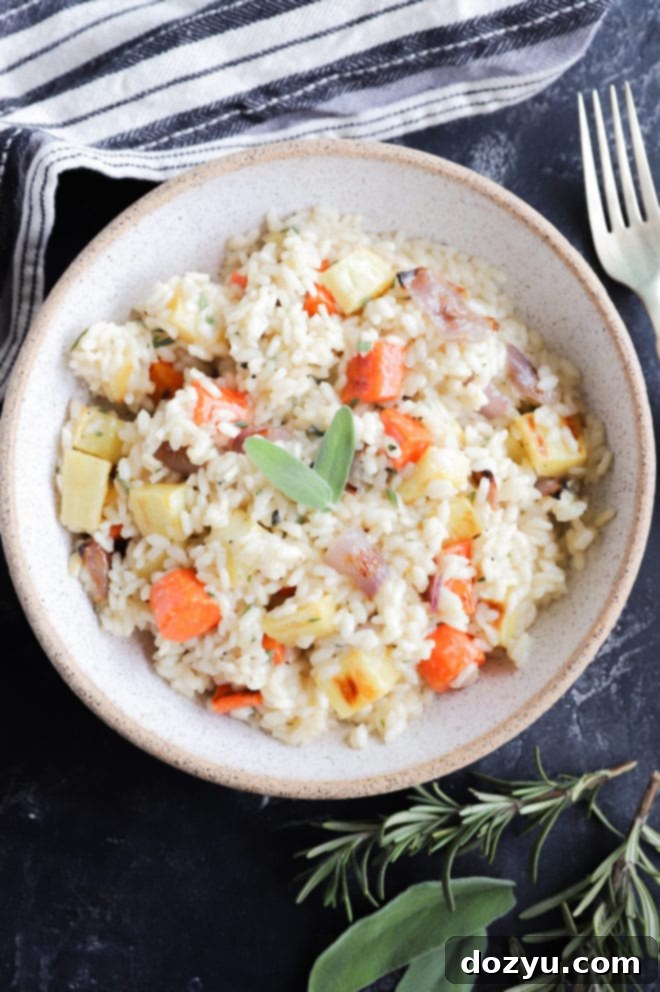
Pro Tips for Risotto Perfection
Making a restaurant-quality risotto at home is within your reach. With a few insider tips and techniques, you can achieve that sought-after creamy texture and rich flavor every single time:
-
Stir Regularly, Not Constantly: While “constant stirring” is often cited as a risotto rule, you don’t actually need to stir every single second. However, regular and consistent stirring is absolutely essential. This action gently agitates the Arborio rice grains, encouraging them to release their starches into the cooking liquid. These starches are what create that signature velvety, creamy texture we all love. It’s a meditative process; I often use this time to put on a favorite show or podcast and simply relish the quiet moments to myself as I cook.
-
Add Stock One Cup at a Time: This is arguably the most critical technique for perfect risotto. The key is to introduce the liquid gradually. Allow each cup of warm stock to be nearly fully absorbed by the rice before adding the next. This slow, controlled absorption process allows the rice to cook evenly, swell properly, and release its starches effectively, ultimately leading to a much creamier and more perfectly textured result. Patience here truly pays off, yielding a risotto that’s tender yet still has a slight bite.
-
Don’t Skip the Butter and Cheese at the End: It might be tempting to cut back on fats, but please, for the love of creamy risotto, do not skip adding the butter and Parmesan cheese at the very end. This final step, known as mantecatura, is non-negotiable for achieving that luxurious, emulsified texture and incredible richness. The butter melts into the rice, creating a beautiful sheen and silken mouthfeel, while the Parmesan adds a depth of savory, umami flavor. Stir them in joyfully – I promise, it’s not a lot in the grand scheme of things, and the difference in taste and texture is monumental!
-
Use Good Quality Ingredients: With a relatively simple dish like risotto, the quality of your ingredients truly shines. Opt for fresh, vibrant vegetables, a good quality Arborio rice, a flavorful stock (homemade if possible!), and real, freshly grated Parmesan cheese. Better ingredients mean better flavor in your finished dish.
-
Serve Immediately: Risotto is a dish that waits for no one! It’s at its absolute best when served straight from the pan, while it’s still warm, creamy, and flowing. As it cools, it will continue to absorb liquid and lose its ideal texture. So, have your plates warmed and your diners ready as soon as it’s finished cooking.
Roasted vs. Sautéed Vegetables: Unlocking Deeper Flavor
You might wonder why we opt for oven-roasted vegetables in this recipe instead of simply sautéing them. The answer lies in the incredible depth of flavor that roasting imparts. High heat in the oven caramelizes the natural sugars in vegetables, intensifying their sweetness and creating complex, nutty notes that sautéing just can’t quite replicate. This process brings out a richness in the parsnips, carrots, and onions that beautifully complements the creamy risotto, adding layers of savory-sweetness.
Beyond the superior flavor, there’s also a practical advantage to roasting: while your risotto is simmering and requiring your attention at the stovetop, your vegetables can be roasting away in the oven, effectively multitasking your cooking process. This simultaneous preparation helps streamline the meal, making it more efficient than cooking everything sequentially on the stovetop. However, if you are truly pressed for time or prefer a different texture, you can certainly sauté the vegetables on the stovetop until tender. Just be aware that the flavor profile will be slightly different, though still delicious.
Customizing Your Risotto: Other Vegetable Ideas
One of the beauties of this Winter Roasted Vegetable Risotto recipe is its incredible adaptability. While the parsnip, carrot, and red onion combination is a fantastic classic for winter, feel free to get creative and incorporate other seasonal vegetables that you enjoy or have on hand. This allows you to tailor the dish to your preferences, what’s freshest at your local market, or simply to add variety.
Here are some excellent seasonal vegetables that can be roasted and swapped into this recipe. Remember to cut any substitute vegetables into similar-sized pieces to ensure even roasting, and adjust roasting times as needed based on the vegetable’s density:
- Beets: Roasting beets brings out their earthy sweetness and softens their texture beautifully. Just a heads-up, if you choose red beets, your risotto will likely take on a lovely, vibrant pink or reddish hue – a fun visual twist that can be quite striking!
- Broccoli or Cauliflower: These cruciferous vegetables roast wonderfully, developing a slightly nutty flavor and tender-crisp texture. They add a great textural contrast to the creamy rice.
- Brussels Sprouts: When roasted until caramelized and slightly crispy on the outer leaves, Brussels sprouts add a delightful bitterness and savory depth that can perfectly balance the richness of the risotto.
- Potatoes or Sweet Potatoes: Cubed and roasted, these will add a heartier, more substantial texture to the dish, making it even more filling. Sweet potatoes will lend an extra layer of natural sweetness.
- Turnips: Similar to parsnips, turnips offer a slightly peppery and earthy flavor that sweetens and mellows significantly with roasting. They provide a unique and delicious alternative.
- Winter Squash (e.g., Butternut, Acorn, Delicata): These are fantastic roasted, adding natural sweetness and a creamy, melt-in-your-mouth texture that blends beautifully with the risotto. Their vibrant colors also make the dish more appealing.
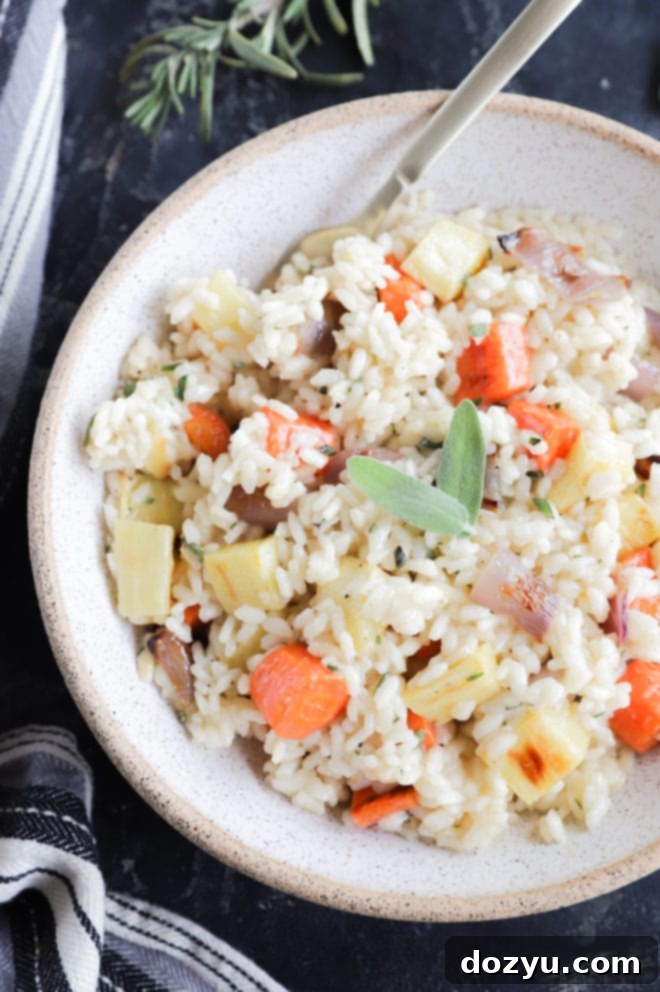
Perfect Pairings: What to Serve with This Risotto
While this creamy Winter Roasted Vegetable Risotto is hearty and flavorful enough to stand alone as a magnificent main course, it also serves as an exquisite and sophisticated side dish to complement your favorite protein. Its rich, earthy flavors and comforting texture make it incredibly versatile for various pairings. You can keep things elegantly simple with grilled chicken or steak, or explore some more creative and equally delicious ideas:
-
Roasted Chicken with White Wine and Herbs: A classic pairing that never disappoints! The savory notes of a perfectly roasted chicken, especially one infused with fragrant herbs and a splash of white wine, will harmonize beautifully with the earthy sweetness of the risotto. It’s an easy protein that comes together quickly, making it a fantastic and elegant weeknight option.
-
Easy Lemon Baked Salmon: For seafood lovers, the bright, fresh flavors of lemon-baked salmon provide a wonderful and healthy contrast to the richness of the risotto. The delicate flakiness of the salmon and the citrusy zest will cut through the creaminess, offering a balanced and invigorating meal. The best part? You can often bake the salmon right in the oven while you’re tending to the risotto on the stovetop, making for an efficient and elegant meal.
-
Chili Coffee Rubbed Steak: For all the red meat enthusiasts, a robust chili coffee rubbed steak offers a bold, smoky, and slightly spicy counterpoint to the creamy, sweet, and herbaceous notes of this winter roasted vegetable risotto. The complexity of the steak rub will create an unforgettable flavor experience when paired with the subtle flavors of the risotto.
-
Grilled Pork Tenderloin: A lean and tender grilled pork tenderloin, perhaps seasoned simply with rosemary and garlic or a light herb rub, would also make a superb accompaniment. Its mild flavor allows the risotto to shine while providing a satisfying, lighter protein option.
-
A Simple Green Salad: If serving the risotto as a hearty main course, a light, crisp green salad with a bright, tangy vinaigrette can provide a refreshing balance. The acidity of the dressing and the freshness of the greens will help cut through the richness of the risotto, making each bite feel lighter.
-
Wine Pairings: For a delightful beverage pairing, consider a crisp, unoaked Chardonnay (especially if you used it in the recipe!), a light-bodied Pinot Noir, or even a dry Rosé. These will complement the earthy and creamy notes without overpowering the dish.
Storing and Reheating Your Leftovers
While risotto is often at its absolute best when enjoyed fresh, you can certainly store and reheat leftovers to extend its deliciousness for another meal. However, it’s important to do so correctly to maintain its appealing texture. Once your risotto has cooled to room temperature (within about an hour of cooking), transfer any leftover portions to an airtight container and store it promptly in the refrigerator. It will keep well for about 2 days. A crucial note: Do NOT freeze risotto. Freezing dramatically changes the delicate texture of the Arborio rice, resulting in a grainy, mushy, and generally unpleasant consistency upon reheating.
To reheat your risotto and bring it back to its creamy glory, gently warm it on the stovetop or in the microwave. The key is to reintroduce moisture. For best results, add 1 tablespoon of unsalted butter and a splash (about 1/4 to 1/2 cup) of white wine, chicken stock, or even water to the risotto before reheating. If using the microwave, heat in 1-minute increments, stirring thoroughly after each interval, until warmed through and creamy. On the stovetop, heat over medium-low heat in a nonstick pan, stirring frequently and gradually adding the liquid until it reaches your desired creamy consistency and serving temperature. The added liquid helps to rehydrate the rice and restore its signature creamy texture, while the butter brings back its richness and glossy sheen.
Deep Dive into Risotto: More Questions Answered
Are you eager to become a true risotto master and deepen your understanding of this beloved Italian dish? If you have more burning questions about the art and science of making perfect risotto, I’ve got you covered! Head over to my comprehensive How to Make Risotto guide. This detailed post dives deep into everything from essential tips for modifying recipes and understanding ingredient substitutions to insights on using different types of liquid (and why I generally don’t recommend plain water!). It’s a treasure trove of information designed to elevate your risotto-making skills from good to truly exceptional.
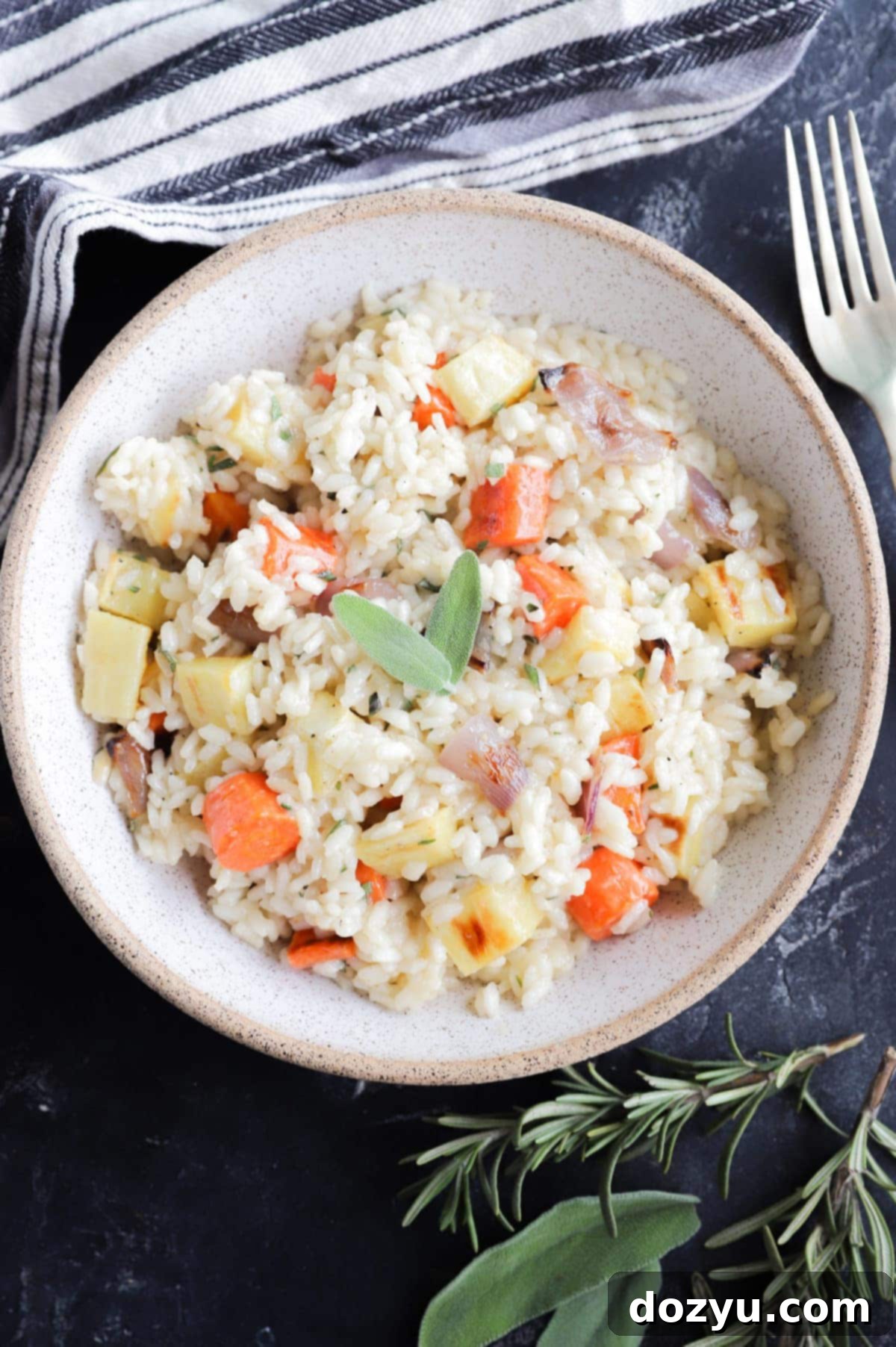
Winter Roasted Vegetable Risotto
Equipment
-
Shun Classic Western Chef’s Knife, 8-Inch
-
Utility Cutting Board
-
Wooden Spoon & Scraper
-
Nonstick 12-Inch Skillet
-
Small Saucepan
-
Baking Sheet
Ingredients
- 1 Tbsp olive oil (for risotto)
- 2 tsp olive oil (for roasting vegetables)
- 1 large parsnip peeled and cut into 1/2-inch pieces
- 2 to 3 carrots peeled and cut into 1/2-inch pieces
- 1/2 red onion peeled and cut into 1-inch pieces
- 3 cups chicken or vegetable stock (warmed)
- 2 garlic cloves minced (or 2 tsp pre-minced)
- 1 cup Arborio rice
- 1 cup dry white wine (e.g., Chardonnay)
- 1/4 cup grated Parmesan cheese
- 1 Tbsp unsalted butter
- 1 tsp freshly chopped sage
- 1 tsp freshly chopped rosemary
- Salt and freshly ground black pepper to taste
Instructions
-
1. Prepare Vegetables: Preheat your oven to 400˚F (200˚C). Line a baking sheet with parchment paper or a silicone mat. In a large bowl, toss the chopped parsnip, carrots, and red onion with 2 teaspoons of olive oil. Season with salt and black pepper. Spread them on the prepared baking sheet and roast until tender and slightly caramelized, about 15 to 20 minutes. Remove from oven and set aside.
-
2. Warm Stock: In a medium saucepan, bring the chicken or vegetable stock to a gentle simmer; cover and keep warm over low heat throughout the risotto cooking process.
-
3. Toast Rice: In a large, high-sided skillet, heat 1 tablespoon of olive oil over medium heat. Add the minced garlic and cook until fragrant and lightly browned, about 1 minute. Stir in the Arborio rice and toast for 2 minutes, stirring occasionally. Add the dry white wine and simmer, stirring, until almost completely evaporated.
-
4. Cook Risotto: Pour in approximately 1 cup of the hot stock. Cook, stirring frequently and gently, until the stock has been almost completely absorbed. Repeat this process, adding 1 cup of stock at a time and stirring until the rice is tender and creamy but still has a slight al dente bite. You may not need all the stock, so taste test the rice between additions. This step typically takes 25 to 35 minutes total.
-
5. Finish & Serve: Remove the skillet from heat. Stir in the grated Parmesan cheese and unsalted butter until both are melted and the risotto is beautifully creamy and glossy. Gently fold in the roasted vegetables and fresh chopped sage and rosemary. Taste and season with additional salt and freshly ground black pepper as needed. Serve immediately.
Nutrition
Carbohydrates: 59g |
Protein: 11g |
Fat: 22g |
Saturated Fat: 5g |
Polyunsaturated Fat: 2g |
Monounsaturated Fat: 13g |
Trans Fat: 0.1g |
Cholesterol: 18mg |
Sodium: 421mg |
Potassium: 534mg |
Fiber: 4g |
Sugar: 7g |
Vitamin A: 5243IU |
Vitamin C: 11mg |
Calcium: 100mg |
Iron: 3mg
